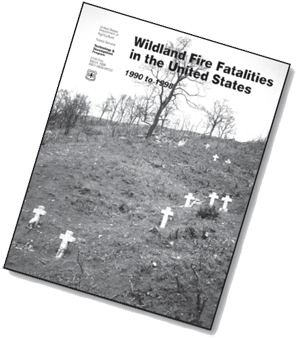Introduction
Wildland firefighting is a high-risk occupation, evidenced each year by deaths or injuries in the line of duty. One way to help reduce wildland firefighter deaths is to identify factors responsible for past fatalities so we can mitigate those factors in future fire seasons.
My interest in firefighter fatalities was fueled by my work on entrapment and fatality investigation teams, beginning with the Dude Fire in 1990 and continuing to the Sawtooth Prescribed Burn fatality in 2003. In 1999, while serving as the Fire, Aviation, and Residues Program Leader at the Forest Service, U.S. Department of Agriculture, Missoula Technology and Development Center (MTDC), I wrote a report on firefighter fatalities, "Wildland Fire Fatalities in the United States: 1990–1998" (figure 1). That report was based on data from the National Wildfire Coordinating Group's (NWCG) Safety and Health Working Team "Safety Gram," issued annually to document firefighter fatalities and entrapment events across the United States. "Wildland Fire Fatalities in the United States: 1990–1998" underreported aircraft accidents by three fatalities and heart attacks by one fatality.
- From 1990 to 2006, 310 persons died during
wildland fire operations.
- The number of wildland fire-related
fatalities increased 26 percent from the
initial period (1990 to 1998) to the most
recent period (1999 to 2006).
- The leading causes of death are now aircraft accidents and vehicle accidents, closely followed by heart attacks.

Figure 1—The 1999 report showed that from 1990 to 1998 burnovers killed
more wildland firefighters than any other cause.
This report, "Wildland Firefighter Fatalities in the United States: 1990–2006," continues to rely on the "Safety Gram," comparing data from the original 9-year period (1990 to 1998, called the initial period) to data from the following 8 years (1999 to 2006, called the most recent period). Fatality data (figure 2) is summarized for the entire 17-year period (1990 to 2006, called the entire period). Because the most recent period is 1 year shorter than the initial period, the basis for comparison between the two periods will be the annual average during each period.
This report is sponsored by the NWCG Safety and Health Working Team and the MTDC Fire and Aviation Program. The Safety and Health Working Team collects and analyzes data to validate and prioritize safety issues and works to improve firefighter health, safety, and effectiveness.

Figure 2—The annual death toll for persons who died during
wildland
fire operations from 1990 to 2006 (310 total deaths).

